
|
|
Version
Table of Contents
1.2 What do you need to understand this book 3
2.3 openCRX Server Installer 4
3 Installing openCRX Server on Windows 6
List of Figures
List of Listings
1 About this Book
This book describes how to install an openCRX Server with the BitRock installer on Windows or Linux platforms. Please note that this is a guide to set up a runtime environment suitable for evaluation and testing purposes. It is not recommended to use this configuration for a production site.
openCRX is the leading enterprise-class open source CRM suite. openCRX is based on openMDX, an open source MDA framework based on the OMG's model driven architecture (MDA) standards. This guarantees total openness, standards compliance, a state-of-the-art component-based architecture, and virtually unlimited scalability.
1.1 Who this book is for
The intended audience are openCRX administrators and advanced users interested in evaluating openCRX.
1.2 What do you need to understand this book
This book describes how to install openCRX with the BitRock installer, which takes care of all the tricky configuration issues for you. The prerequisites are minimal (JDK and Apache Ant) and once they are met you should have openCRX up and running in less than 5 minutes.
1.3 Tips, Warnings, etc.
We make use the following pictograms:
|
|
Information provided as a “Tip” might be helpful for various reasons: time savings, risk reduction, etc. - it goes without saying that we advise to follow our guides meticulously meticulous
\muh-TIK-yuh-luhs\, adjective: |
|
|
You should carefully read information marked with “Important”. Ignoring such information is typically not a good idea. |
|
|
Warnings should not be ignored (risk of data loss, etc.) |
2 Prerequisites
2.1 JDK 6.0
Download and install the Sun Java JDK 6.0
available
from
http://www.oracle.com/technetwork/java/javase/downloads/jdk-6u25-download-346242.html
|
|
You really need Java 6, i.e. neither Java 4 nor Java 5 will work. |
|
|
It is not sufficient to have a Java Runtime Environment (JRE) only. The full-blown JDK is required to run openCRX. |
|
|
On Windows, it is a good idea to avoid paths containing blanks like the default installation directory ...\Program Files\.... |
|
|
Don't forget to set the environment variable JAVA_HOME. It should point to your JDK installation directory, e.g. to D:\Java\jdk1.6.0 on Windows or opt/jdk1.6.0 on Linux. |
2.2 Ant 1.8.0
Download Ant 1.8.0 (available from http://ant.apache.org/) for your platform and install it by expanding the downloaded file to a directory of your choice.
|
|
Don't forget to set the environment variable ANT_HOME as follows: ANT_HOME should point to the installation directory of Ant, e.g. D:\apache-ant-1.8.0 on Windows or /opt/apache-ant-1.8.0 on Linux. |
2.3 openCRX Server Installer
Download the openCRX Server Installer appropriate for your platform from Sourceforge: http://www.opencrx.org/downloads.htm
Installer for
Windows:
opencrxServer-2.8.5-windows-installer.exe
Installer
for Linux:
opencrxServer-2.8.5-linux-installer.bin
The openCRX Server installer installs Apache TomEE, the openCRX EAR, an openCRX database (HSQLDB) and various configuration files on your system.
|
|
Please note that HSQLDB is not exactly a high performance DBMS nor is it meant to be used as a productive DBMS for openCRX. However, it gets lots of points for “ease of installation” and that is what counts for getting off the ground fast. Once you're comfortable with openCRX you can easily migrate to another DBMS without losing any data. More information about choosing a suitable DBMS and migrating from HSQLDB to another DBMS is available here: |
2.4 Hardware
We recommend a decent CPU and at least 2GB RAM. More detailed information about the requirements of openCRX are available from http://www.opencrx.org/faq.htm#hardware
3 Installing openCRX Server on Windows
Launch the Installer opencrxServer-2.8.5-windows-installer.exe
Click [Next] on the following screen:
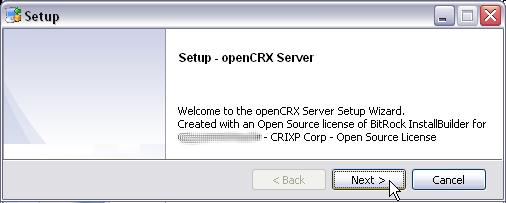
Accept the BSD License Agreement and click [Next] again:
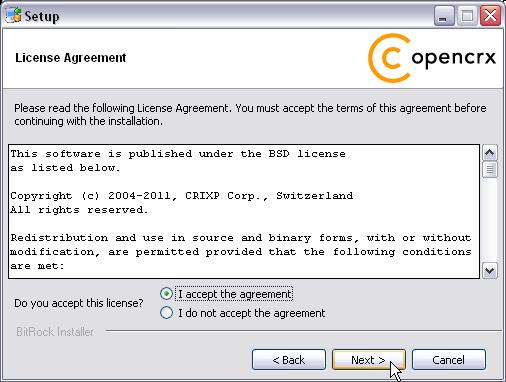
Choose an installation directory (instead of 2.8.5 you will be seeing the respective openCRX version number; the directory will be created automatically if it does not exist yet). Then click [Next] to continue:
-

On Windows it is a good idea to avoid paths containing blanks like the default installation directory ...\Program Files\...
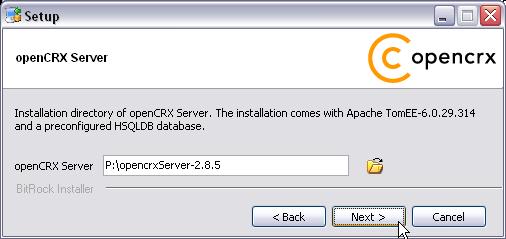
Select the home directory of your JDK 1.6 installation - for example D:\Java\jdk1.6.0_25 - and then click [Next] to continue:
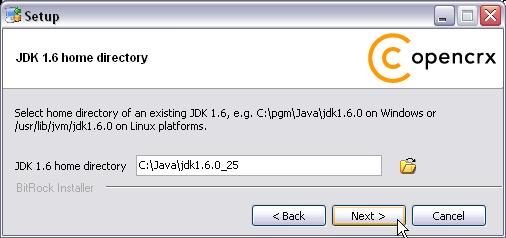
Select the home directory of your Ant installation – for example
D:\apache-ant-1.8.0 - and then click [Next] to continue: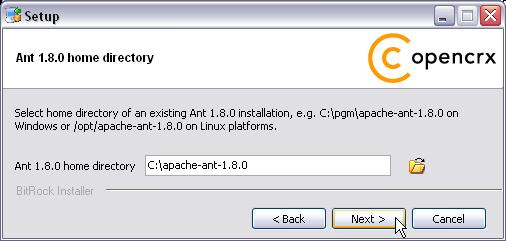
Enter the port number of the HSQLDB service. You can choose any port available on your system. The default is 9001. Click [Next] to continue:
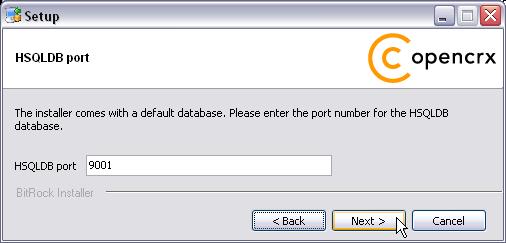
Enter the Tomcat ports (defaults are shown below). Please note that Tomcat does not start properly unless it has exclusive use of these ports, i.e. make sure that the chosen ports are indeed available. Click [Next] to continue:
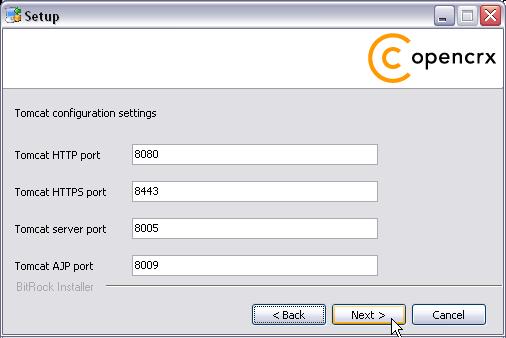
Finally, click [Next] to start the installation:
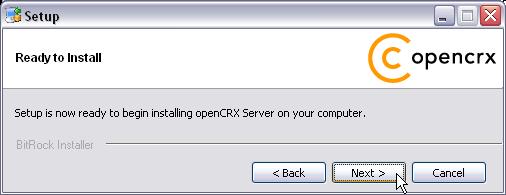
Verify that the post installation completed with errors and then click [OK]:
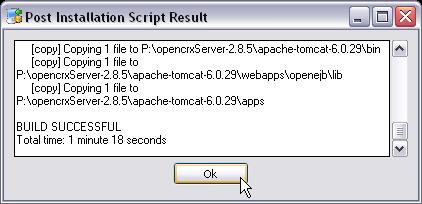
Once the installation is complete, click [Finish] on the last screen:
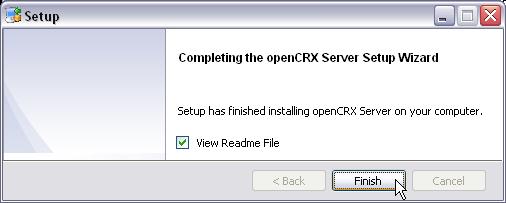
Finally, please carefully read the README, in particular information about valid URLs, preconfigured users and passwords:
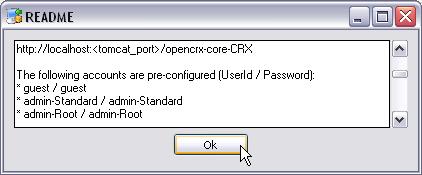
The installer created a few shortcuts in your menu Start > Programs:
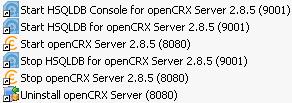
That's it for the installation. Move on to chapter 5 (Running openCRX Server).
4 Installing openCRX Server on Linux
|
|
There is no need to install openCRX as root. We created a user crx and the whole installation procedure is done as user crx. In case your system is GUI-less, you can launch the installer in text/console mode with the parameter --mode text. |
Launch the Installer opencrxServer-2.8.5-linux-installer.bin (on 32bit systems) or opencrxServer-2.8.5-linux-x64-installer.bin (on 64bit systems)
Click [Forward] on the following screen:
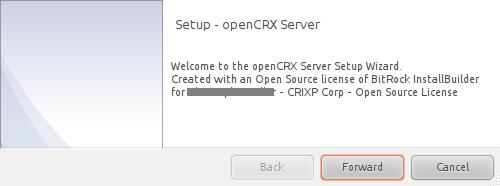
Accept the BSD License Agreement and click [Forward] again:
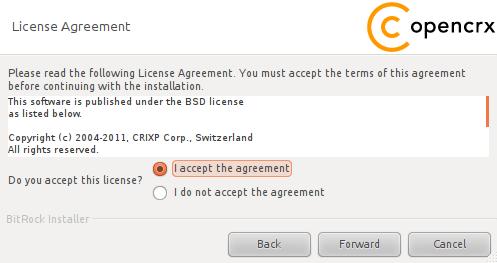
Choose an installation directory (instead of 2.8.5 you will be seeing the respective version number); it will be created automatically if it does not exist yet). Then click [Forward] to continue:
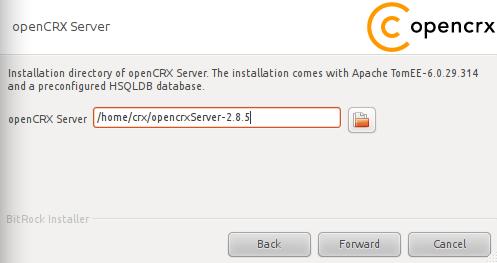
Select the home directory of your JDK 1.6 installation - for example
/opt/jdk1.6.0_25 - and then click [Forward] to continue: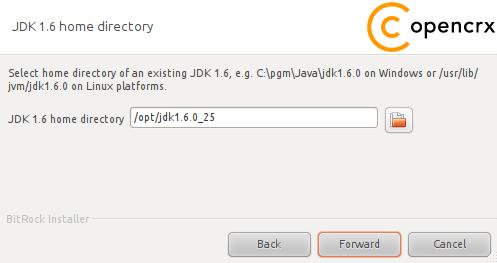
Select the home directory of your Ant installation – for example /opt/apache-ant-1.8.0 – and then click [Forward] to continue:
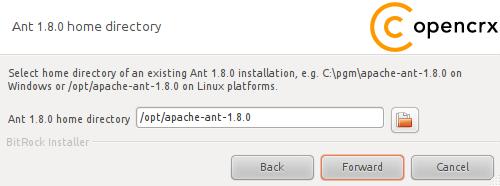
Enter the port number of the HSQLDB service. You can choose any port available on your system. The default is 9001. Click [Forward] to continue:
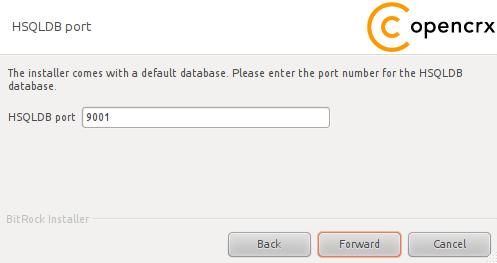
Enter the Tomcat ports (defaults are shown below). Please note that Tomcat does not start properly unless it has exclusive use of these ports, i.e. make sure that the ports you choose are not already in use. Click [Next] to continue:
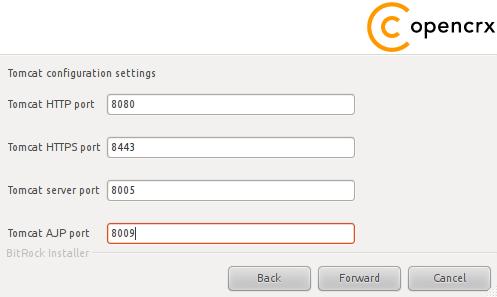
Next, click [Forward] to start the installation:

Verify that the post installation completed without errors (at the bottom you should see BUILD SUCCESSFUL) – and then click [OK]:

Once the installation is complete, click [Finish] on the last screen:
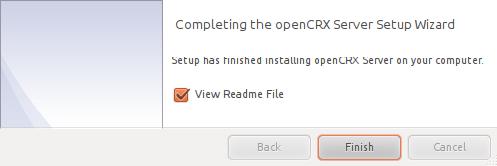
Finally, please carefully read the README, in particular information about valid URLs, preconfigured users and passwords:

The installer created a few shortcuts/launchers in the installation directory:
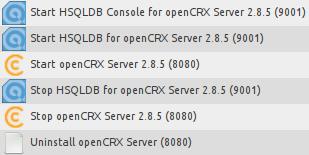
That's it for the installation.
Move on to chapter 5 (Running openCRX Server).
5 Running openCRX Server
The installation process created various shortcuts in your Windows Start Menu (shortcuts/launchers in your installation directory on Linux). Your version numbers might be different depending on the Tomcat version included in the installer:
|
|
Start
Tomcat+OpenEJB and |
|
|
Stop
Tomcat+OpenEJB and |
|
|
Start HSQLDB |
|
|
Stop HSQLDB |
|
|
Launch HSQLDB Management Console |
5.1 Start openCRX Server
Start openCRX Server by launching the shortcut [Start Tomcat + OpenEJB].
5.2 Connect and Login
Launch your browser and navigate to http://localhost:8080/opencrx-core/CRX/ (the port may be different from 8080 depending on your selection/input during the installation):
http://localhost:8080/opencrx-core-CRX/
If you want to define a favorite/shortcut/bookmark in your browser, use the following URL: http://localhost:8080/opencrx-core-CRX/Login.jsp (again, adapt the port 8080 as required).
If you want to load the login page in a specific language, see information at http://www.opencrx.org/faq.htm#login on how to do it.
|
|
Initialization takes place during the first login after (re)starting Tomcat, so please be patient. Subsequent logins will be very fast. |
5.3 Stop openCRX Server
Double-click the shortcut Stop openCRX Server (and HSQLDB).
6 Next Steps
Now that you have successfully installed openCRX you might want to have a look at some of the additional documentation published at http://www.opencrx.org/documents.htm.
License
The contents of this file are
subject to a BSD license (the "License"); you may not use
this file except in compliance with the License. You may obtain a
copy of the License at http://
Copyright 2011 ©
CRIXP Corp. All rights reserved. ![]()

